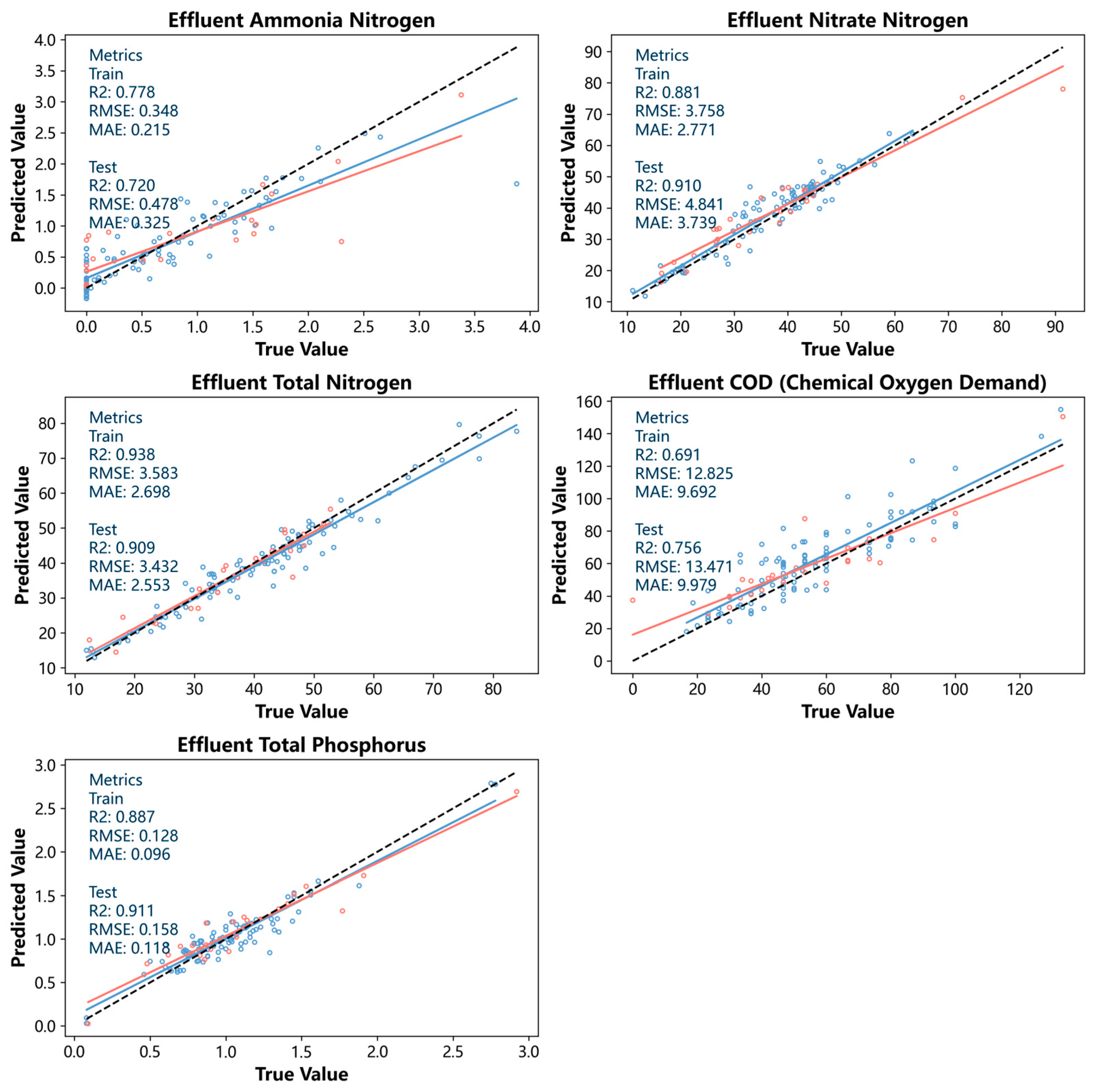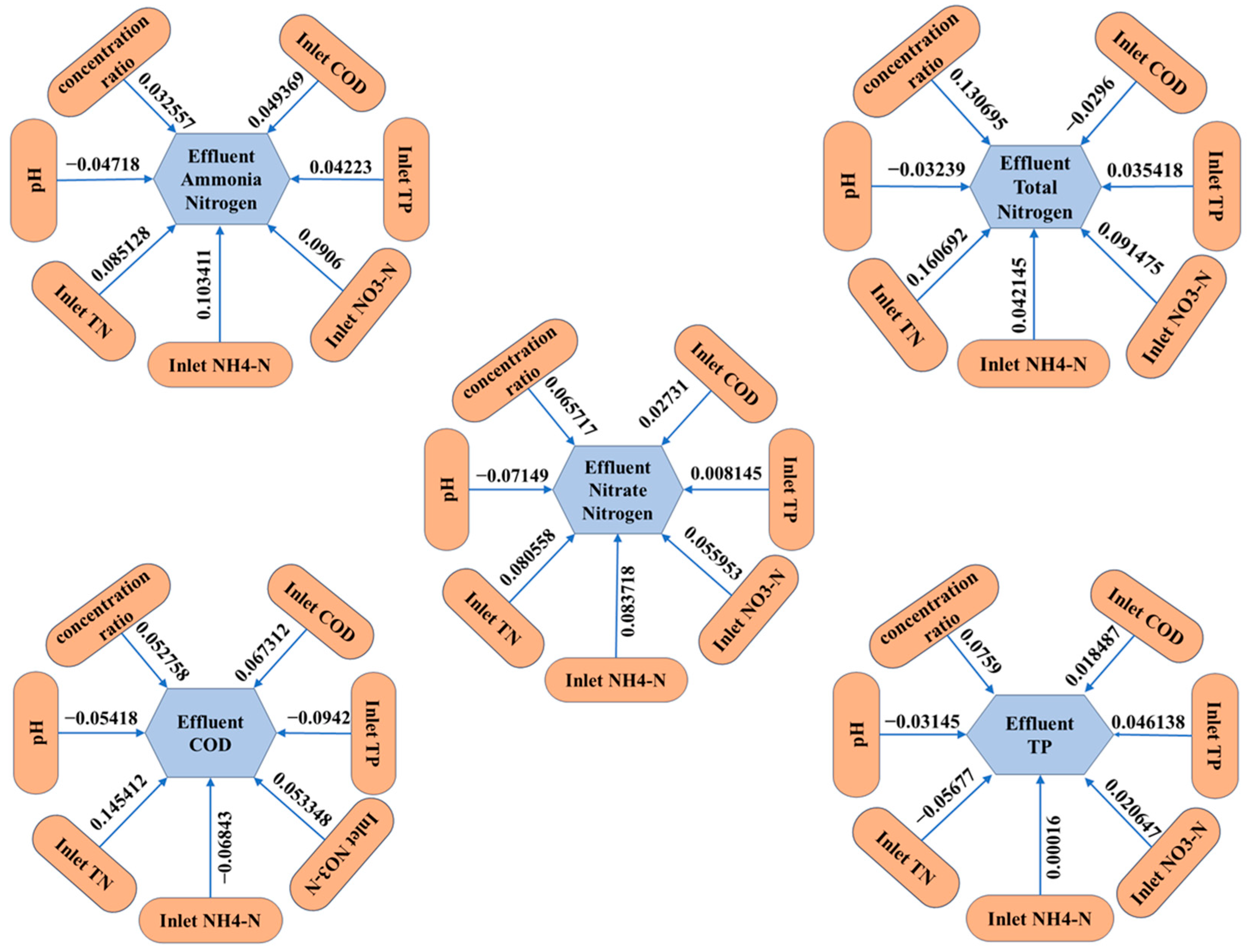Prediction of Typical Power Plant Circulating Cooling Tower Blowdown Water Quality Based on Explicable Integrated Machine Learning
Abstract
:1. Introduction
2. Materials and Methods
2.1. Sample Data from Paper Industrial Wastewater Treatment Plant
2.2. Data Preprocessing
2.3. TCN Neural Network
2.4. Construction of TCN Prediction Model
2.5. Predictive Performance Evaluation Metrics
2.6. Hyperparameter Setting
2.7. Causal Inference Model (EconML)
2.8. Shapley Additive Explanations (SHAP)
2.9. Environment
3. Results and Discussion
3.1. Results of the TCN Model
3.2. Comparison of Different Models
3.3. Causal Inference
3.4. SHAP Analysis
4. Conclusions
- (1)
- The TCN model demonstrated superior predictive performance for ammonia nitrogen, nitrate nitrogen, total nitrogen, COD, and total phosphorus in the effluent of the power plant’s circulating cooling tower, achieving a high fitting accuracy with low RMSE and MAE values.
- (2)
- Compared to traditional models such as XGBoost and SVR, the TCN achieved a higher R² and maintained prediction times under 1 s, supporting its suitability for real-time water quality monitoring despite slightly longer training times.
- (3)
- Causal inference analysis revealed that effluent water quality is most strongly influenced by the corresponding parameters in the makeup water, followed by the concentration ratio, highlighting the dominant role of influent quality in determining discharge characteristics.
- (4)
- SHAP analysis indicated that higher inflow pH (>7) reduces effluent concentrations of ammonia nitrogen, nitrate nitrogen, total nitrogen, COD, and total phosphorus, likely due to enhanced volatilization, microbial inhibition, and improved degradation. While increasing the concentration ratio raises impurity levels and inhibits microbial activity, its influence plateaus around a ratio of 5, suggesting a dynamic equilibrium state.
Supplementary Materials
Author Contributions
Funding
Data Availability Statement
Acknowledgments
Conflicts of Interest
Abbreviations
| XGBoost | eXtreme Gradient Boosting |
| SVM | Support Vector Machine |
| CNNs | Convolutional Neural Networks |
| LSTM | Long Short-Term Memory |
| TCN | Temporal Convolutional Network |
| SHAP | Shapley Additive Explanations |
| COD | Chemical Oxygen Demand |
| RMSE | Root Mean Square Error |
| MAE | Mean Absolute Error |
| TT | Inference Time |
| EconML | Causal Inference Model |
References
- Mekonnen, M.M.; Gerbens-Leenes, P.W.; Hoekstra, A.Y. The consumptive water footprint of electricity and heat: A global assessment. Environ. Sci.-Water Res. Technol. 2015, 1, 285–297. [Google Scholar] [CrossRef]
- Macknick, J.; Meldrum, J.; Nettles-Anderson, S.; Heath, G.; Miara, A. Life cycle water use for photovoltaic electricity generation: A review and harmonization of literature estimates. In Proceedings of the 2014 IEEE 40th Photovoltaic Specialist Conference (PVSC), Denver, CO, USA, 8–213 June 2014; pp. 1458–21460. [Google Scholar]
- Pan, S.-Y.; Snyder, S.W.; Packman, A.I.; Lin, Y.J.; Chiang, P.-C. Cooling water use in thermoelectric power generation and its associated challenges for addressing water-energy nexus. Water-Energy Nexus 2018, 1, 26–41. [Google Scholar] [CrossRef]
- Chafa, A.T.; Chirinda, G.P.; Matope, S. Design of a real-time water quality monitoring and control system using Internet of Things (IoT). Cogent Eng. 2022, 9, 2143054. [Google Scholar] [CrossRef]
- Nong, X.Z.; He, Y.; Chen, L.H.; Wei, J.H. Machine learning-based evolution of water quality prediction model: An integrated robust framework for comparative application on periodic return and jitter data. Environ. Pollut. 2025, 369, 125834. [Google Scholar] [CrossRef]
- Libera, D.A.; Sankarasubramanian, A. Multivariate bias corrections of mechanistic water quality model predictions. J. Hydrol. 2018, 564, 529–541. [Google Scholar] [CrossRef]
- Zhu, J.J.; Yang, M.Q.; Ren, Z.J. Machine Learning in Environmental Research: Common Pitfalls and Best Practices. Environ. Sci. Technol. 2023, 57, 17671–17689. [Google Scholar] [CrossRef]
- Safeer, S.; Pandey, R.P.; Rehman, B.; Safdar, T.; Ahmad, I.; Hasan, S.W.; Ullah, A. A review of artificial intelligence in water purification and wastewater treatment: Recent advancements. J. Water Process Eng. 2022, 49, 102974. [Google Scholar] [CrossRef]
- Alvi, M.; Batstone, D.; Mbamba, C.K.; Keymer, P.; French, T.; Ward, A.; Dwyer, J.; Cardell-Oliver, R. Deep learning in wastewater treatment: A critical review. Water Res. 2023, 245, 120518. [Google Scholar] [CrossRef]
- El-Rawy, M.; Abd-Ellah, M.K.; Fathi, H.; Ahmed, A.K.A. Forecasting effluent and performance of wastewater treatment plant using different machine learning techniques. J. Water Process Eng. 2021, 44, 102380. [Google Scholar] [CrossRef]
- Xiang, Y.R.; Jiang, L.Z. Water Quality Prediction Using LS-SVM with Particle Swarm Optimization. In Proceedings of the 2009 Second International Workshop on Knowledge Discovery and Data Mining, Moscow, Russia, 23–25 January 2009; pp. 900–904. [Google Scholar]
- Huang, R.X.; Ma, C.X.; Ma, J.; Huangfu, X.L.; He, Q. Machine learning in natural and engineered water systems. Water Res. 2021, 205, 117666. [Google Scholar] [CrossRef]
- Huan, J.; Fan, Y.X.; Xu, X.G.; Zhou, L.W.; Zhang, H.; Zhang, C.; Hu, Q.C.; Cai, W.X.; Ju, H.R.; Gu, S.L. Deep learning model based on coupled SWAT and interpretable methods for water quality prediction under the influence of non-point source pollution. Comput. Electron. Agric. 2025, 231, 109985. [Google Scholar] [CrossRef]
- Ahmed, A.A.; Sayed, S.; Abdoulhalik, A.; Moutari, S.; Oyedele, L. Applications of machine learning to water resources management: A review of present status and future opportunities. J. Clean. Prod. 2024, 441, 140715. [Google Scholar] [CrossRef]
- APHA. Standard Methods for the Examination of Water and Wastewater, 21st ed.; American Public Health Association: Washington, DC, USA, 2012. [Google Scholar]
- Yang, H.; Zhao, X.; Wang, L. Review of Data Normalization Methods. Comput. Eng. Appl. 2023, 59, 13–22. [Google Scholar] [CrossRef]
- Zuo, H.Y.; Gou, X.T.; Wang, X.; Zhang, M.Y. A Combined Model for Water Quality Prediction Based on VMD-TCN-ARIMA Optimized by WSWOA. Water 2023, 15, 4227. [Google Scholar] [CrossRef]
- Hodson, T.O. Root-mean-square error (RMSE) or mean absolute error (MAE): When to use them or not. Geosci. Model Dev. 2022, 15, 5481–5487. [Google Scholar] [CrossRef]
- Chernozhukov, V.; Chetverikov, D.; Demirer, M.; Duflo, E.; Hansen, C.; Newey, W.; Robins, J. Double/debiased machine learning for treatment and structural parameters. Econom. J. 2018, 21, C1–C68. [Google Scholar] [CrossRef]
- Yao, L.Y.; Chu, Z.X.; Li, S.; Li, Y.L.; Gao, J.; Zhang, A.D. A Survey on Causal Inference. ACM Trans. Knowl. Discov. Data 2021, 15, 74. [Google Scholar] [CrossRef]
- Bordt, S.; von Luxburg, U. From Shapley Values to Generalized Additive Models and back. In Proceedings of the 26th International Conference on Artificial Intelligence and Statistics, PMLR, Valencia, Spain, 25–27 April 2023. [Google Scholar]
- Lundberg, S.M.; Lee, S.I. A Unified Approach to Interpreting Model Predictions. In Proceedings of the 31st Conference on Neural Information Processing Systems (NIPS 2017), Long Beach, CA, USA, 4–9 December 2017. [Google Scholar]
- Qian, S.T.; Qiao, X.Y.; Zhang, W.M.; Yu, Z.J.; Dong, S.A.; Feng, J.G. Machine learning-based prediction for settling velocity of microplastics with various shapes. Water Res. 2024, 249, 121001. [Google Scholar] [CrossRef]
- Zhang, X.; Li, D.S. Multi-input multi-output temporal convolutional network for predicting the long-term water quality of ocean ranches. Environ. Sci. Pollut. Res. 2023, 30, 7914–7929. [Google Scholar] [CrossRef]
- Dong, S.; Wang, P.; Abbas, K. A survey on deep learning and its applications. Comput. Sci. Rev. 2021, 40, 100379. [Google Scholar] [CrossRef]
- Chen, J.S.; Ran, X.K. Deep Learning With Edge Computing: A Review. Proc. IEEE 2019, 107, 1655–1674. [Google Scholar] [CrossRef]
- Quick, A.M.; Reeder, W.J.; Farrell, T.B.; Tonina, D.; Feris, K.P.; Benner, S.G. Nitrous oxide from streams and rivers: A review of primary biogeochemical pathways and environmental variables. Earth-Sci. Rev. 2019, 191, 224–262. [Google Scholar] [CrossRef]
- Capson-Tojo, G.; Moscoviz, R.; Astals, S.; Robles, A.; Steyer, J.P. Unraveling the literature chaos around free ammonia inhibition in anaerobic digestion. Renew. Sustain. Energy Rev. 2020, 117, 109487. [Google Scholar] [CrossRef]
- Zhang, F.Z.; Du, Z.Y.; Wang, J.H.; Du, Y.J.; Peng, Y.Z. Acidophilic partial nitrification (pH < 6) facilitates ultra-efficient short-flow nitrogen transformation: Experimental validation and genomic insights. Water Res. 2024, 260, 121921. [Google Scholar]
- Low, S.J. Determination of Activation Energy of Saponification Reactionthrough pH Analysis. Res. Rev. J. Chem. 2017, 6, 1–5. [Google Scholar]
- Amaro, H.M.; Salgado, E.M.; Nunes, O.C.; Pires, J.C.M.; Esteves, A.F. Microalgae systems- environmental agents for wastewater treatment and further potential biomass valorisation. J. Environ. Manag. 2023, 337, 117678. [Google Scholar] [CrossRef]
- Hanson, A.J.; Luek, J.L.; Tummings, S.S.; McLaughlin, M.C.; Blotevogel, J.; Mouser, P.J. High total dissolved solids in shale gas wastewater inhibit biodegradation of alkyl and nonylphenol ethoxylate surfactants. Sci. Total Environ. 2019, 668, 1094–1103. [Google Scholar] [CrossRef]
- Liu, J.; Zhi, Q.; Hu, X. Analysis and measures of pH rising for circulating water in indirect air cooling unit. In International Conference on Mechatronics and Intelligent Control (ICMIC 2024); SPIE: St Bellingham, WA, USA, 2024; Volume 13447, pp. 625–628. [Google Scholar]
- Esu, O.C.; Pyo, J.; Cho, K. Machine learning-derived dose-response relationships considering interactions in mixtures: Applications to the oxidative potential of particulate matter. J. Hazard. Mater. 2024, 475, 134864. [Google Scholar] [CrossRef]





Disclaimer/Publisher’s Note: The statements, opinions and data contained in all publications are solely those of the individual author(s) and contributor(s) and not of MDPI and/or the editor(s). MDPI and/or the editor(s) disclaim responsibility for any injury to people or property resulting from any ideas, methods, instructions or products referred to in the content. |
© 2025 by the authors. Licensee MDPI, Basel, Switzerland. This article is an open access article distributed under the terms and conditions of the Creative Commons Attribution (CC BY) license (https://creativecommons.org/licenses/by/4.0/).
Share and Cite
Wan, Y.; Tian, X.; He, H.; Tong, P.; Gao, R.; Ji, X.; Li, S.; Luo, S.; Li, W.; Chen, Z. Prediction of Typical Power Plant Circulating Cooling Tower Blowdown Water Quality Based on Explicable Integrated Machine Learning. Processes 2025, 13, 1917. https://doi.org/10.3390/pr13061917
Wan Y, Tian X, He H, Tong P, Gao R, Ji X, Li S, Luo S, Li W, Chen Z. Prediction of Typical Power Plant Circulating Cooling Tower Blowdown Water Quality Based on Explicable Integrated Machine Learning. Processes. 2025; 13(6):1917. https://doi.org/10.3390/pr13061917
Chicago/Turabian StyleWan, Yongjie, Xing Tian, Hanhua He, Peng Tong, Ruiying Gao, Xiaohui Ji, Shaojie Li, Shan Luo, Wei Li, and Zhenguo Chen. 2025. "Prediction of Typical Power Plant Circulating Cooling Tower Blowdown Water Quality Based on Explicable Integrated Machine Learning" Processes 13, no. 6: 1917. https://doi.org/10.3390/pr13061917
APA StyleWan, Y., Tian, X., He, H., Tong, P., Gao, R., Ji, X., Li, S., Luo, S., Li, W., & Chen, Z. (2025). Prediction of Typical Power Plant Circulating Cooling Tower Blowdown Water Quality Based on Explicable Integrated Machine Learning. Processes, 13(6), 1917. https://doi.org/10.3390/pr13061917





